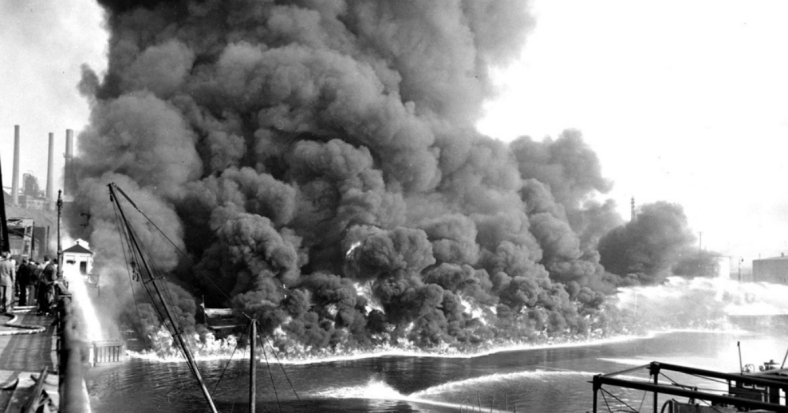This Week’s Prompt:50. Phleg′-e-thon: a river of liquid fire in Hades.
The Resulting Story:Ill Fated Boat Ride
This week’s prompt appropriately enough brings us back to one of the richest goldmines that Mr. Lovecraft employs: Classical imagery and mythology. In this case, the Phlegethon, one of the rivers that runs along Hades, providing a boundary marker. The river itself is often described as alit with fire, flowing ( or “coiling”) into the depths of Tarturus, the closest thing to an infernal domain the Greeks had.

Fittingly, then, Phlegethon has been maintained past the Classics into the imagery of Hell provided by Christian authors. Dante describes it as a river of blood and violence, boiling over as murderers and war criminals were forced to stay in it by patrolling centaurs. Milton places it and the other four rivers as parts of hell explored by the fallen angels, before the idea of tempting mortals is introduced. The Faeire Queene by Spencer has it scorch sinners, and even Mr. Lovecraft included it in the work “the Other Gods”.
However, as strange as a river of fire might sound, it is not alone in peculiar underworld rivers. Rivers, being natural dividers and boundary markers, often arise around the land of the dead, many with strange contents. Hubur, the Sumerian river of the dead, held dead souls in it’s depths against their will. Sillias, a river reported by a Greek traveler in India, allows nothing to float, but rather drags everything into it’s depths. The Vaitarna River is, to the sinless, a river of nectar. To the sinner, it appears filled with blood, bones, and pus. When the sinner approaches, flames appear everywhere. Those who try and cross, and are in fact sinners, will burn forever in the whirlpools in it’s depths.

And of course there is Xibalba. Xibalba has a number of rivers. A river of blood, yes, but also a river of pus and a river of scorpions. These rivers mark the roads and borders of the Maya realm of the dead, to keep the living out and the dead within. The rivers must be crossed successfully,
These rivers often have fearsome guardians. Hubur has monsters with many arms demonic birds, the Phelegthon has it’s centaurs in Dante, and Vaitarna has hundreds of crocodiles and birds to devour the flesh of sinners before the cross.

Of course, rivers of fire are not merely fantastical. There are multiple records of polluted rivers bursting into flames or exploding, sometimes for shockingly long periods at a time. The resonance of damned souls burning and industrial waste igniting is perhaps not an accident. It is a potent image, fire snaking it’s way down what ought to be it’s relief, a boiling mass of suffering from what is normally life giving.

Rivers role with the dead we’ve discussed here, when talking of suicides at bridges, and here with Davey Jones. The river’s leading inexorably down to a place of punishment is not one we’ve directly addressed. However, as an image and mode for a story, flowing down a river unwittingly to doom seems as good a premise as any to describe the arc of a story. The realm of the dead is near the edge of the river, the damned are just below it’s surface struggling to be free.
I would focus on the rivers, then, and the journey down them rather than the dead itself. It can keep the story somewhat more grounded then we’ve been lately, more in the realm of the mortal than the completely supernatural. I’d suggest a borderline between the surreal but natural occurrence of flaming rivers and the wholly supernatural rivers of fire and hell would be a good place to work. A place of uncertainty, where the danger is real, but the extent is not completely clear. And the river is a good place to set such a story. Rivers are border places, where parties of either side might meet. It is a perpetual threshold between two places, endowed with motion onward.
The other recurring image is the attempt (and failure) to cross the river by sinful souls or inquisitive dead. Xibalba is the exception, of course, having been crossed and overthrown by the Maya Hero Twins, and even then it had more confounding traps past the river. Vaitarna allows people to cross with proper preparations, offerings, or after a lengthy time of suffering. Other rivers are generally safe to the sinless, a sort of natural filter.

And of course, with many of these, the role of supernatural ferryman is a strong image. A ferryman who is more aware of the nature of the river and what’s around it. Charon serves this roll for the Styx, Guru’s for the Vaitarna, Virgil for Dante. These more than human guides might have a place in our story as well.
Come next week to see what corpse we pull from the boiling blood, and what it’s appearance resembles!
If you’d like to support the Society, receive more stories or research, or are feeling generous, please check out our Patreon here.

Are the modern rivers of fire a manifestation of corporate sinfulness, i.e. failing to care for the creation?
LikeLiked by 1 person
It’d be a good metaphor connection, yeah. Dante’s bit is more on violence (…someone somewhere has probably connected pollution to violence against the earth I’m sure).
LikeLike